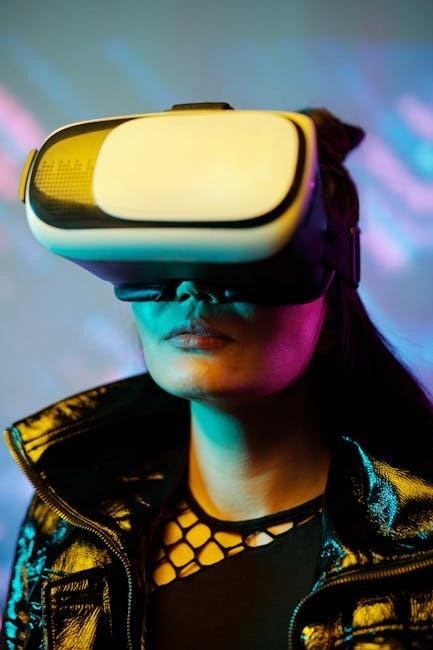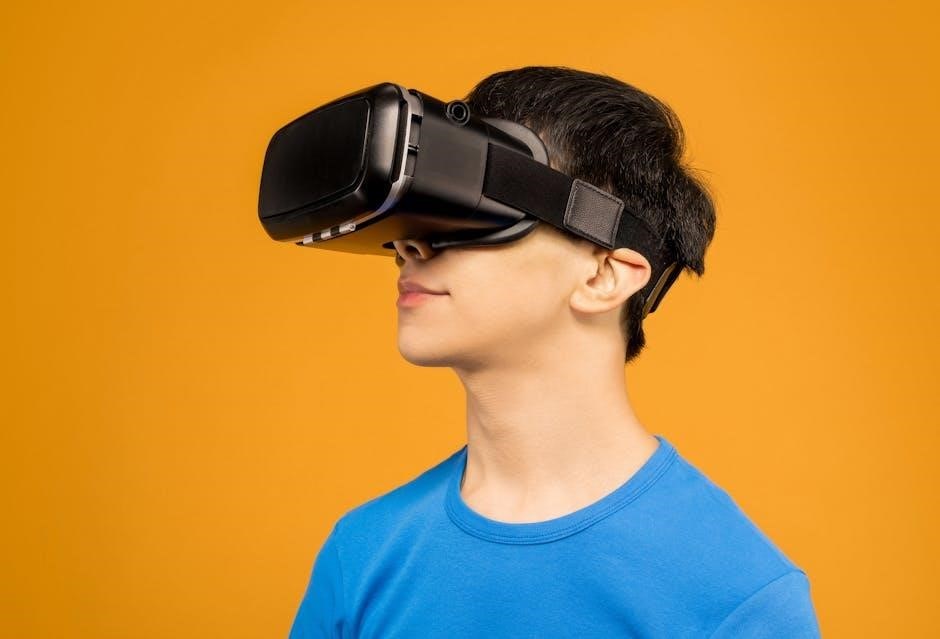simulacra simulation pdf
Jean Baudrillard’s Simulacra and Simulation (1981) explores how society replaces reality with hyperreal images, creating a world dominated by simulations rather than genuine experiences.
1.1. Overview of Jean Baudrillard’s Concept
Jean Baudrillard’s concept of simulacra and simulation introduces the idea that modern society has become dominated by hyperreal images and models that replace authentic reality. In his seminal work, Baudrillard argues that simulacra—copies without an original—shape human perception, leading to a world where the distinction between reality and illusion blurs. He describes simulation as a process where signs and symbols generate a “hyperreal” that is more influential than actual events or experiences. This theory critiques how media, technology, and consumer culture create and disseminate these simulacra, leading to the implosion of meaning and the erasure of the real. Baudrillard’s framework provides a critical lens for understanding postmodern society’s obsession with representation over reality.
1.2. Historical Context of the Essay
Jean Baudrillard’s essay Simulacra and Simulation was first published in 1981, emerging during a period of significant cultural and technological transformation in the late 20th century. The work reflects the rise of postmodern thought, challenging traditional notions of reality and truth. Baudrillard’s ideas were influenced by the increasing dominance of mass media, consumer culture, and digital technologies, which he saw as driving forces behind the creation of hyperreal simulacra. The essay gained prominence in academic circles and beyond, particularly resonating with discussions on postmodernity, media studies, and critical theory. Its historical context is marked by the decline of grand narratives and the ascendancy of a world shaped by images, signs, and simulations, setting the stage for Baudrillard’s critical analysis of contemporary society.

The Precession of Simulacra
Baudrillard’s concept of the precession of simulacra describes how simulations precede and shape reality, creating a hyperreal world where models replace the real in influencing society.
2.1. The Simulacrum and Its Relation to Reality
The simulacrum, as Baudrillard explains, is a copy without an original, a representation that replaces reality rather than reflecting it. It is not merely an imitation but a substitution, where the simulation becomes indistinguishable from the real. In contemporary society, simulacra are pervasive, shaping perceptions and experiences. They operate by masking the absence of an underlying truth, creating a hyperreal world where the simulation is more influential than the reality it represents. This relationship fundamentally alters how individuals interact with and understand their surroundings, leading to a world dominated by images and models rather than authentic phenomena.
2.2. The Hyperreal and Its Implications
The hyperreal, a concept central to Baudrillard’s theory, refers to the state where simulations and models of reality become more real than reality itself. This phenomenon arises when society replaces genuine experiences with representations, leading to a world where the hyperreal dominates. The hyperreal is not just a reflection of reality but a construction that reshapes perceptions, often making the simulation more impactful than the real; In this context, media, technology, and consumer culture play significant roles in creating and sustaining hyperreal experiences. The implications are profound, as the hyperreal can alter societal values, politics, and culture by creating a reality that is perceived as more authentic than the actual world. This shift challenges traditional notions of truth and authenticity, leaving society suspended in a web of constructed meanings.

History: A Retro Scenario
Baudrillard argues that history is shaped by simulations, where events are reconstructed through models and narratives, blurring the line between reality and hyperreality, altering our understanding.
3.1. Baudrillard’s Perspective on Historical Narratives
Jean Baudrillard contends that historical narratives are shaped by simulations, where events are reconstructed through models and narratives, often blurring the distinction between reality and hyperreality. He argues that history is no longer a reflection of genuine events but a retroactive construction, influenced by cultural and political agendas. This perspective suggests that our understanding of the past is mediated by simulacra, which replace the real with representations that are often more compelling than reality itself. Baudrillard illustrates this with examples like the Holocaust, where media representations and cultural narratives have transformed the event into a hyperreal phenomenon, detached from its historical context. Ultimately, he challenges the notion of objective history, proposing instead that it is a product of simulation and reinterpretation.
3.2. The Role of Simulation in Shaping History
Baudrillard argues that simulation fundamentally reshapes our understanding of history by replacing real events with hyperreal representations; Historical narratives are no longer grounded in objective facts but are reconstructed through models, media, and cultural interpretations. This process transforms history into a “retro scenario,” where the past is continually reinterpreted to serve contemporary agendas. Simulation creates a hyperreal version of history, detaching it from its original context and meaning. For instance, events like the Holocaust are often represented through mediated narratives, which become more influential than the actual historical occurrence. Baudrillard contends that simulation thus erodes the distinction between history and fiction, leaving us with a world where the hyperreal dominates over the real.

The Holocaust
Baudrillard examines the Holocaust as a simulacrum, arguing that its representation in media and collective memory transforms it into a hyperreal event, blurring the line between reality and its constructed narrative.
4.1. The Event as a Simulacrum
Jean Baudrillard argues that the Holocaust has become a simulacrum, a copy without an original, detached from its historical reality. Through media and collective memory, the event is reinterpreted and reconstructed, losing its direct connection to the past. The Holocaust, as a simulacrum, is shaped by cultural narratives, political agendas, and emotional resonance, transforming it into a hyperreal representation. This process detaches the event from its historical context, reducing it to a symbolic marker of horror and morality. Baudrillard contends that this transformation obscures the actual historical truth, replacing it with a mediated version that serves contemporary ideological purposes. The simulacrum of the Holocaust, therefore, reflects how society constructs and consumes historical events in a hyperreal world.
4.2. Media Representation and the Hyperreal Holocaust
The Holocaust, as portrayed in media, exemplifies the hyperreal, where simulations of the event dominate public perception. Films, documentaries, and literature create a mediated reality that often overshadows historical facts. These representations, while aiming to educate, frequently emphasize emotional impact over accuracy, fostering a hyperreal Holocaust. Baudrillard argues that this hyperreality, shaped by media narratives, constructs a version of the event that is more accessible but less authentic. The result is a cultural phenomenon where the Holocaust is consumed as a symbol of evil, detached from its specific historical context. Media thus perpetuates a simulacrum of the Holocaust, reinforcing its hyperreal status in contemporary consciousness. This process underscores how media shapes collective memory, often prioritizing emotional resonance over historical truth.

The China Syndrome
Baudrillard examines political simulacra, where media representations of events like the “China Syndrome” create hyperreal narratives, shaping public perception beyond actual political realities.
5.1. Political Simulacra in Global Contexts
In Simulacra and Simulation, Baudrillard argues that political events are often reduced to simulacra, where media representations replace actual political realities. These simulacra, such as the “China Syndrome,” are hyperreal constructs that shape public perception. Global politics is dominated by models and signs that simulate authenticity, creating a detachment from real political issues. Baudrillard contends that such simulacra are not mere distortions but entirely self-referential systems, operating independently of truth. This phenomenon reflects the broader implosion of meaning in political discourse, where symbols and narratives substitute for tangible actions and ideologies. The PDF version of Baudrillard’s work highlights how these simulacra perpetuate power structures, masking the erosion of genuine political engagement. Ultimately, political simulacra in global contexts illustrate the hyperreal’s dominance over reality.
5.2. The Implosion of Meaning in Political Discourse
In Simulacra and Simulation, Baudrillard examines how political discourse succumbs to the implosion of meaning, where symbols and narratives replace substantive issues. This phenomenon arises as simulacra—copies without originals—dominate political communication, creating a void of genuine meaning. The hyperreal constructs of media and ideology perpetuate this collapse, reducing complex realities to simplistic, manipulable models. Baudrillard argues that this implosion reflects a broader societal shift, where the pursuit of power and control outweighs the pursuit of truth. The PDF version of his work elaborates on how this erosion of meaning undermines democratic processes, leaving political discourse as a hollow shell of its former self. Ultimately, the implosion of meaning in political discourse highlights the profound challenges of engaging with reality in a hyperreal world.

Apocalypse Now
Apocalypse Now exemplifies how war becomes a simulacrum, where the Vietnam War is portrayed as a hyperreal experience, blending reality and fiction into a mediated spectacle.
6.1. The Simulacrum of War in Popular Culture
In Simulacra and Simulation, Baudrillard examines how war becomes a hyperreal construct, particularly through media representation. Popular culture, such as films like Apocalypse Now, portrays war as a simulacrum, blending reality and fiction. These depictions create a layered reality where the actual events are obscured by their mediated representations. The Vietnam War, for instance, is often perceived through the lens of Hollywood narratives, which simplify and dramatize its complexities. This process transforms war into a spectacle, detaching it from its historical and political contexts. Consequently, society engages with war as a simulation, rather than confronting its raw, unfiltered truth. This phenomenon underscores Baudrillard’s argument about the dominance of hyperreality in shaping cultural perceptions.
6.2. The Hyperreal and the Vietnam War
Baudrillard’s concept of the hyperreal is exemplified by the Vietnam War’s media portrayal. The war was heavily televised, turning it into a spectacle where images and narratives replaced direct experience. Media coverage created a hyperreal version of the conflict, emphasizing dramatic battles and emotional stories while obscuring the war’s political complexities. This hyperreality shaped public perception, making the war a simulation of itself. Baudrillard argues that this process detached the war from its actual historical context, reducing it to a series of images and symbols. The hyperreal Vietnam War became more impactful than the events themselves, illustrating how media constructs reality in a postmodern world.
The Beaubourg Effect: Implosion and Deterrence
Baudrillard’s Beaubourg Effect describes how cultural institutions like the Pompidou Center implode meaning, becoming simulacra of culture rather than authentic spaces for critical engagement and reflection.
7.1. The Museum as a Simulacrum of Culture
Baudrillard’s concept of the Beaubourg Effect highlights how museums, like the Pompidou Center, function as simulacra of culture. These institutions no longer serve as authentic spaces for preserving or engaging with cultural artifacts but instead become hyperreal spectacles; The museum’s role shifts from curating meaningful experiences to creating consumer-friendly environments that prioritize entertainment over intellectual or historical depth. This transformation reflects a broader societal trend where cultural institutions implode under the weight of their own simulacra, losing their original purpose and becoming mere reflections of a hyperreal world. The museum, in this sense, is no longer a repository of culture but a space where culture is commodified and consumed passively, reinforcing the dominance of simulation over reality.
7.2. The Implosion of Cultural Meaning
Baudrillard’s theory of cultural implosion suggests that meaning collapses under the weight of hyperreal simulations. In the context of museums and cultural institutions, this implosion occurs when symbols and signs of culture become detached from their original contexts and historical significance. The hyperreal replaces the real, transforming cultural artifacts into commodities for mass consumption. This process erodes the authenticity of cultural experiences, reducing them to superficial spectacles. The museum, as a simulacrum of culture, exemplifies this implosion, where the cultural narrative is fragmented and reassembled into a form that prioritizes entertainment over depth. As a result, cultural meaning becomes hollow, leaving behind a void filled only by the echoes of simulation.
Hypermarket and Hypercommodity
Hypermarkets exemplify hyperreality, where consumption is saturated with signs and models, replacing authentic experiences with hyperreal simulations that dominate consumer culture.
8.1. The Hyperreal in Consumer Culture
In hypermarkets, consumer culture is saturated with hyperreal images and simulations. Products are marketed through idealized representations, creating a reality more appealing than the actual. The hyperreal dominates consumer spaces, shaping perceptions and desires. This phenomenon leads to a disconnect between the product’s true nature and its marketed image, as the hyperreal becomes the standard. Consumer culture thrives on these simulations, reinforcing the idea that the hyperreal is more valuable than the real. Baudrillard’s concept highlights how hyperreality in consumerism replaces authentic experiences with manufactured desires, transforming the marketplace into a realm of signs and models rather than tangible realities.
8.2. The Commodification of Reality
The commodification of reality, as explored in Baudrillard’s work, reveals how hyperreal constructs dominate contemporary life. Reality is transformed into a commodity, mediated by images, signs, and simulations. This process erases the distinction between the authentic and the artificial, leading to a world where reality is no longer experienced but consumed. The hyperreal, shaped by media and technology, becomes the primary lens through which society interprets existence. As a result, genuine experiences are replaced by manufactured ones, and the value of reality is measured by its marketability. This commodification perpetuates a cycle where the simulation of reality is more desirable than reality itself, further entrenching the hyperreal as the dominant form of human experience.

The Implosion of Meaning in the Media
The media’s role in fostering simulacra leads to the collapse of meaningful narratives, as information overload and hyperreal representations replace authentic truths, eroding the distinction between fact and fiction.
9.1. The Role of Media in Creating Simulacra
The media plays a central role in constructing simulacra by disseminating hyperreal images and narratives that replace authentic experiences. Through repetition and fragmentation, media distorts reality, creating a world of signs and symbols that lack a tangible referent. Baudrillard argues that media simulation operates by generating models of reality that are more convincing than reality itself. This process erodes the distinction between the real and the artificial, leading to a society where hyperreal constructs dominate perception and understanding. Media’s ability to shape public consciousness ensures that simulacra are perpetually reinforced, making it increasingly difficult to discern truth from illusion.
9.2. The Death of the Real in Media Representation
Baudrillard’s concept of the “death of the real” highlights how media representation replaces authentic reality with hyperreal constructs. Media, through its selective framing and repetition, creates simulacra that overshadow actual events and experiences. These hyperreal images, devoid of tangible referents, become the dominant narrative, leading to the erosion of the real. The relentless circulation of these mediated representations in society perpetuates their acceptance as reality, further diminishing the real’s significance. Consequently, the real becomes obscured, and its relevance fades as hyperreal simulations capture public consciousness. This process illustrates Baudrillard’s assertion that media’s role in shaping perceptions leads to the decline of the real, immersed in a world of simulacra.

Absolute Advertising, Absolute Implosion
Baudrillard examines how advertising operates as a simulacrum of desire, creating hyperreal images that implode meaning. Ads craft idealized fantasies, disconnecting consumers from reality and fostering empty consumption.
10.1. Advertising as a Simulacrum of Desire
Advertising functions as a simulacrum of desire, crafting hyperreal images that simulate ideal lifestyles and emotions. These constructs, devoid of real substance, create longing for unattainable ideals.
10.2. The Implosion of Meaning in Advertising
Advertising exemplifies the implosion of meaning, as it relies on signs and models that simulate desire rather than representing real needs. Through hyperreal imagery and narratives, ads create a void where genuine meaning once existed. This implosion occurs as symbols and images lose their connection to reality, becoming self-referential systems that perpetuate consumption. Baudrillard argues that advertising no longer sells products but lifestyles and fantasies, further eroding the distinction between the real and the simulated. The consumer, trapped in this hyperreal loop, seeks fulfillment in commodities that promise meaning but deliver only temporary illusion. Thus, advertising becomes a perfect example of how simulation displaces reality, leaving behind a hollow shell of meaning.


